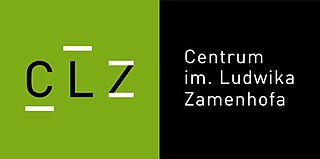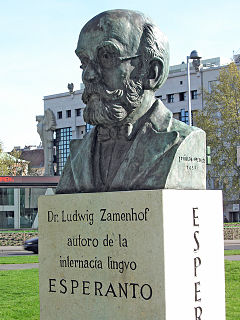 W
WThe Esperanto jubilee symbol is a cultural symbol that was created in 1987 to mark the 100th anniversary of Esperanto. Because of its shape, the symbol is sometimes informally called the melon (melono), egg (ovo) or rugby ball.
 W
WThe Esperanto flag and other Esperanto symbols have seen much consistency over the time of the language's existence, though a few variations in exact flag patterning and symbology have been seen. The main flag of Esperanto, featuring the Verda Stelo, was adopted in 1905 for use as a symbol of mutual recognition among Esperantists. This flag is used by most Esperantists, though the jubilea simbolo has been more recently proposed in 1987 as an alternative.
 W
WThe Château de Grésillon is situated 250 km to the southwest of Paris in Baugé between Angers, Le Mans and Tours in France.
 W
WA gufujo, plural gufujoj, in Esperanto slang, is a non-alcoholic, non-smoking makeshift European café-type situation that takes place in the evening or at night. Esperanto speakers meet at a location, either a rented space or someone's house, and enjoy live music or reading aloud while having tea, coffee, pastries etc. There may be payment with real money expected, as in a real café. It's supposed to be a calm affair, in direct contrast to the wild parties that other Esperanto speakers might be having elsewhere at the same time. The lighting is usually dim and candles are usually lit, which is the custom in European cafés in the evening. Gufujoj were originally intended for people who dislike crowd noise and partying.
 W
W"La Espero" is a poem written by Polish-Jewish doctor L. L. Zamenhof (1859–1917), the initiator of the Esperanto language. The song is often used as the anthem of Esperanto, and is now usually sung to a triumphal march composed by Félicien Menu de Ménil in 1909. It is sometimes referred to as the hymn of the Esperanto movement.
 W
WThe Ludwik Zamenhof Centre is a city cultural institution established in Bialystok at 19 Warszawska St. upon the motion of the President of the City. It was founded to celebrate the organization of the 94th World Congress of Esperanto that was held from 25 July to 1 August 2009 in Bialystok. The Centre was officially opened for the visitors on 21 July 2009. At the beginning The Zamenhof Centre was a branch of The Centre of Culture in Bialystok, but it has been an autonomous cultural unit since January 2011.
 W
WLa Plena Pekoteko is a three-volume terminology collection extending to 1,816 pages. The word Pekoteko is an abbreviated version of Per-komputora termino-kolekto.
 W
WEdith Alleyne Sinnotte was an Australian writer of British origin. She is best known as the first female Esperanto novelist.
 W
WThe spesmilo is an obsolete decimal international currency, proposed in 1907 by René de Saussure and used before World War I by a few British and Swiss banks, primarily the Ĉekbanko Esperantista.
 W
WThe Esperanto Wikipedia is the Esperanto version of Wikipedia, which was started on 11 May 2001, alongside the Basque Wikipedia. With over 294,000 articles as of June 2016, it is the 32nd-largest Wikipedia as measured by the number of articles, and the largest Wikipedia in a constructed language.
 W
WZamenhof Day, also called Esperanto Book Day, is celebrated on 15 December, the birthday of Esperanto creator L. L. Zamenhof. It is the most widely celebrated day in Esperanto culture. On this day, Esperantists hold information sessions and cultural gatherings to promote literature in Esperanto.
 W
WA Zamenhof-Esperanto object is a monument or a place linked to L. L. Zamenhof, the constructed language Esperanto he created and first published in 1887, or the community of Esperanto speakers which has been using the language since.